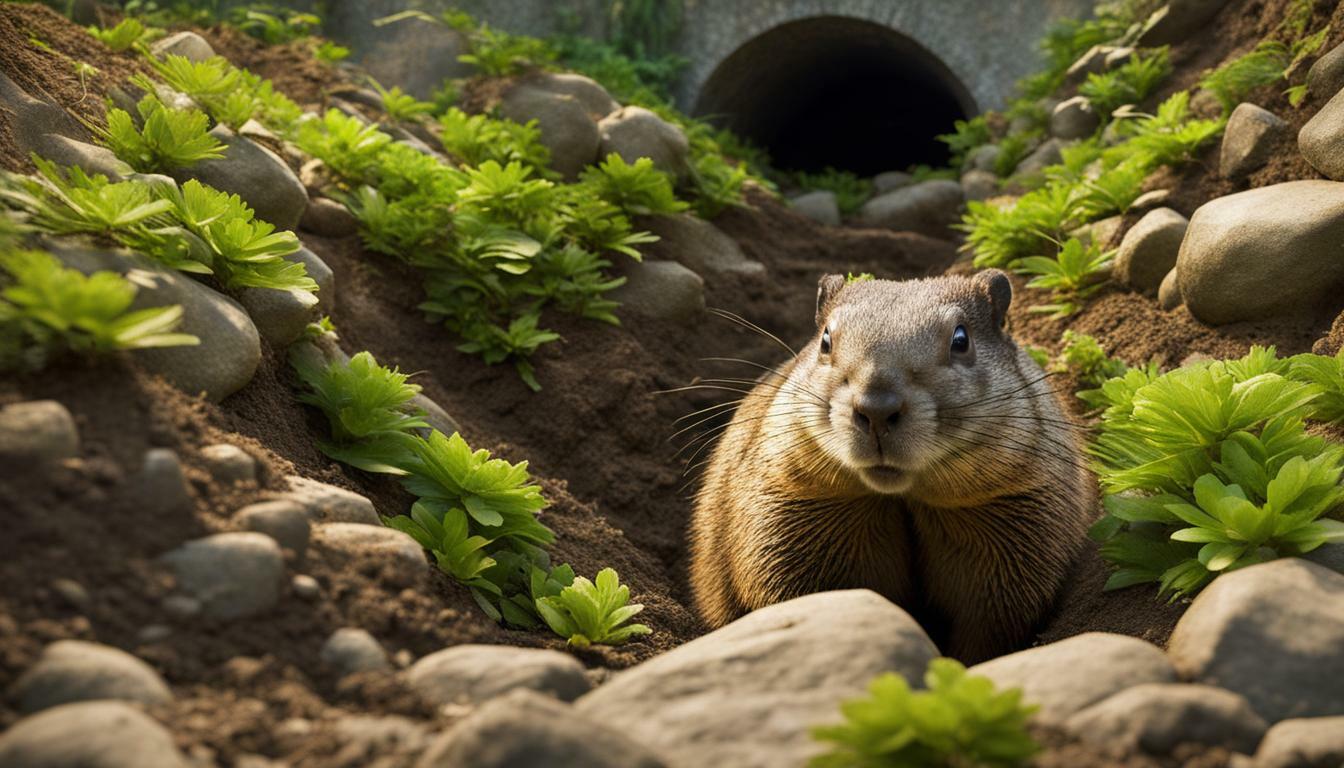Groundhog tunnels can measure up to 65 feet in total length, making them impressive structures in the animal kingdom. These tunnels are created by groundhogs using their powerful claws to dig through the ground. The excavated dirt is then carried in their mouths to the main entrance of the burrow. While the main entrance is usually marked by a mound of dirt, groundhogs also have hidden exits that allow them to move discreetly.
Groundhogs are solitary animals, and only one groundhog will live in a burrow at a time. During hibernation, groundhogs seal off a small section of their tunnels with dirt, providing them with insulation and protection from the cold. Interestingly, these sealed-off sections can also be occupied by other animals seeking shelter during the winter months.
Aside from their impressive length, groundhog tunnels play a vital role in the ecosystem. Their digging activities help aerate the soil, which promotes better growth for plants. Additionally, groundhog burrows provide habitats for various wildlife, including small mammals and reptiles.
Key Takeaways:
- Groundhog tunnels can reach lengths of up to 65 feet.
- Groundhogs use their powerful claws to dig and carry dirt in their mouths to the burrow entrance.
- The main entrance of a groundhog burrow is often marked by a mound of dirt.
- Groundhogs are solitary animals, with only one groundhog occupying a burrow at a time.
- During hibernation, groundhogs seal off a section of their burrow, which can be occupied by other animals seeking shelter.
- Groundhog tunnels help aerate the soil and provide habitats for other wildlife.
Exploring Groundhog Burrows
Groundhogs use their powerful claws to dig their burrows, creating intricate tunnel systems that provide shelter and safety. These burrows, also known as dens, can vary in size and dimensions. Groundhog hole dimensions can range from a few feet to more than 60 feet in length, with multiple chambers and tunnels branching off from the main entrance.
These habitat tunnels serve as the primary residence for groundhogs, providing protection from predators and extreme weather conditions. The tunnels are typically dug at a depth of 2 to 5 feet underground, ensuring a stable and secure environment. The dimensions of groundhog burrows can vary depending on various factors, including the availability of suitable soil and the age of the groundhog.
Inside the burrow, groundhogs create separate chambers for different purposes. One chamber is used for sleeping and resting, while another serves as a toilet area. The larger chambers are used for nesting and storing food. The complex network of tunnels and chambers allows groundhogs to move freely and safely within their burrows.
| Chamber | Function |
|---|---|
| Sleeping chamber | Provides a cozy space for groundhogs to rest and sleep. |
| Toilet area | A designated spot for groundhogs to relieve themselves. |
| Nesting chamber | Used for giving birth and raising young groundhogs. |
| Food storage chamber | Stores food for the winter months when groundhogs hibernate. |
Groundhog burrow measurements are often conducted to better understand the behavior and habits of these fascinating creatures. Researchers use techniques such as ground-penetrating radar and manual excavation to determine the precise length and dimensions of the burrows. This information helps in studying the ecological impact of groundhog burrows and their role in providing shelter for other wildlife.
The Construction Process
Groundhogs excavate the soil with their claws, carrying it in their mouths to create their burrows while ensuring proper dimensions for their needs. The length of groundhog tunnels can vary, with some reaching up to 65 feet in total length. These tunnels serve as a safe and secure home for groundhogs, providing protection from predators and the harsh elements.
The construction of a groundhog burrow involves a meticulous process. Groundhogs dig tunnels underground, using their powerful front claws to create a network of interconnected chambers and passageways. They carefully shape the tunnels to accommodate their size, allowing them to move comfortably throughout their burrow.
Groundhogs are known for their engineering skills, and their burrows can have multiple entrances and exits. The main entrance is usually marked by a mound of dirt, which is a result of the excavated soil being pushed up and out. However, groundhogs also create hidden exits, allowing them to enter and exit their burrows discreetly.
| Construction Process | Dimensions |
|---|---|
| Excavation | Groundhogs use their claws to dig tunnels |
| Transportation | They carry the soil in their mouths |
| Shaping | Groundhogs carefully shape the tunnels to ensure proper dimensions |
| Main Entrance | Marked by a mound of dirt |
| Hidden Exits | Allows groundhogs to move discreetly |
Groundhogs are solitary animals, and only one groundhog occupies a burrow at a time. However, during winter hibernation, groundhogs seal off a small section of their tunnels with dirt. This helps them conserve energy and provides protection during their dormant period. Interestingly, other animals such as rabbits, skunks, and foxes may also seek shelter in these burrows during the winter months.
These intricate groundhog tunnels serve a larger purpose beyond providing a home for individual groundhogs. They play a vital role in aerating the soil, allowing oxygen to reach plant roots and promoting healthier vegetation. The tunnels also provide habitats for other wildlife, serving as nesting grounds and shelter for various species. Groundhog burrows can attract a diverse range of animals, contributing to the overall biodiversity of an ecosystem.
The Main Entrance and Hidden Exits
The main entrance of a groundhog burrow is typically marked by a noticeable mound of dirt, but these resourceful animals also create hidden exits throughout their tunnel system. Groundhogs have a remarkable ability to create intricate networks of tunnels, with some measuring up to 65 feet in total length. They use their powerful claws to dig the tunnels, tirelessly excavating the earth.
As groundhogs dig their tunnels, they carry the dirt in their mouths and deposit it at the main entrance, forming a distinct mound that serves as a clear indicator of their burrow’s location. This mound also helps to protect the main entrance from flooding during heavy rain. However, groundhogs are clever enough to create alternative exits that are more discreet and hidden from predators. These hidden exits allow them to move around their tunnel system without drawing attention.
Groundhogs are solitary animals, and each burrow is typically occupied by only one individual. During hibernation, which lasts from late fall to early spring, groundhogs seal off a small section of their tunnels with dirt to create a cozy chamber. This section, known as the hibernaculum, provides insulation and protection from the cold weather. It is within this secluded chamber that groundhogs enter a state of deep sleep, conserving energy until the arrival of spring.
| Fact | Data |
|---|---|
| Total tunnel length | Up to 65 feet |
| Number of groundhogs in a burrow | Usually only one |
| Hibernation period | Late fall to early spring |
Groundhog burrows not only provide shelter for the animals themselves, but they also play an important ecological role. By creating tunnels in the soil, groundhogs help to aerate the ground, improving its overall health and fertility. Additionally, their burrows offer habitats for other wildlife, such as rabbits, skunks, and snakes, who take advantage of the existing underground structures.
In conclusion, groundhog burrows are fascinating structures that serve as homes for these solitary animals. They consist of intricate tunnel systems, with a main entrance marked by a mound of dirt and hidden exits that provide discreet access. These burrows help groundhogs survive harsh winters and contribute to the ecological balance of their habitat.
Solitary Living
Groundhogs are solitary creatures, with each burrow typically housing only one individual, providing them with a secure and personal living space. These burrows, also known as dens, are carefully constructed by the groundhogs themselves. Using their powerful claws, they dig tunnels that can stretch up to 65 feet in total length. As they excavate the dirt, groundhogs carry it in their mouths to the main entrance of the burrow, where it forms a distinctive mound of dirt.
While the main entrance is easily visible, groundhogs also have hidden exits scattered throughout their tunnel system. These exits allow them to move discreetly and avoid predators. Inside the burrow, groundhogs create multiple chambers for different purposes, including sleeping, eating, and hibernating during the winter months.
Speaking of hibernation, groundhogs seal off a small section of their tunnels with dirt to create a cozy chamber for their winter slumber. During this time, other animals may seek refuge in the unused parts of the burrow, taking advantage of the warmth and protection it provides. Groundhogs’ solitary nature ensures they have exclusive access to their burrows, allowing them to maintain control over their territory.
| Key Takeaways: |
|---|
| – Groundhogs live alone in their burrows, with each den accommodating only one individual. |
| – Burrows can stretch up to 65 feet in total length, with hidden exits providing additional escape routes. |
| – Groundhogs seal off a section of their burrows during hibernation, while other animals may seek shelter in the unused parts. |
In summary
Groundhogs are solitary creatures that create burrows up to 65 feet long. These tunnels provide them with a secure and personal living space. Groundhogs use their powerful claws to dig and shape the tunnels, carrying the dirt in their mouths to the main entrance where it forms a distinctive mound. Hidden exits allow them to move discreetly, while inside the burrow, multiple chambers serve different purposes. During hibernation, groundhogs seal off a small section of their tunnels, providing a cozy chamber for themselves. Other animals may seek refuge in the unused parts of the burrow during this time. Overall, these solitary creatures play a vital role in maintaining healthy ecosystems by aerating the soil and providing habitats for other wildlife.
Winter Adaptations
During hibernation, groundhogs seal off a portion of their burrows with dirt, creating a snug and protected space to endure the winter months. These sealed sections help to maintain a stable temperature and prevent predators from entering. The dirt acts as insulation, keeping the inner chambers of the burrow relatively warm even as temperatures drop outside.
Inside their burrows, groundhogs experience a significant decrease in metabolic rate, breathing slows, and body temperature drops. This hibernation allows them to conserve energy and survive without food until the spring. Groundhogs rely on their burrows for protection from the harsh winter conditions, making them vital for their survival.
While groundhogs hibernate, their burrows can also serve as temporary shelters for other animals seeking refuge from the cold. Various wildlife species, such as rabbits, skunks, and even foxes, may take advantage of the abandoned tunnels to find warmth and protection. This interdependence between groundhogs and other animals further highlights the ecological importance of these burrows.
Groundhog Burrow Diagram
Below is a simple diagram illustrating the structure of a groundhog burrow:
| Section | Description |
|---|---|
| Main Entrance | The primary entrance to the burrow, typically marked by a mound of dirt. |
| Living Chambers | The primary living area where groundhogs rest and raise their young. |
| Hibernation Chamber | A specially sealed section of the burrow where groundhogs enter a state of hibernation during winter. |
| Escape Tunnels | Additional exits that allow groundhogs to flee quickly if they sense danger. |
Understanding the winter adaptations of groundhogs and the structure of their burrows offers insights into the fascinating ways in which these animals adapt and survive in their natural habitats. It also underscores the vital ecological role that groundhog burrows play in supporting biodiversity and providing shelter for various wildlife species.
Ecological Importance
Groundhog burrows play a vital role in the ecosystem, contributing to soil aeration and acting as homes for various other animals. These underground tunnels, with their extensive networks, provide shelter for a diverse range of wildlife, making them an essential component of the local habitat.
One of the key benefits of groundhog burrows is their impact on soil aeration. As groundhogs dig and navigate their tunnels, they loosen the soil, allowing for better oxygenation. This process enhances the soil’s ability to support plant growth and nutrient absorption, benefiting the surrounding vegetation and promoting a healthier ecosystem.
In addition to their role in soil aeration, groundhog burrows act as crucial shelters for other animals. These underground tunnels can provide safe havens for various species, including rabbits, foxes, and reptiles. The intricate network of tunnels offers protection from predators and extreme weather conditions, allowing these animals to thrive in their natural environment.
Species That Rely on Groundhog Burrows
| Animal Species | Role in the Ecosystem |
|---|---|
| Rabbits | Seek shelter in groundhog burrows to avoid predators |
| Foxes | Use abandoned groundhog burrows as den sites for raising their young |
| Reptiles | Utilize groundhog burrows for hibernation and protection during colder months |
By promoting soil health and supporting a diverse range of wildlife, groundhog burrows contribute significantly to the overall ecological balance of their habitats. Protecting these tunnels and the groundhogs that create them is crucial for maintaining biodiversity and preserving the natural beauty of our landscapes.
Groundhog Tunnels and Wildlife
Groundhog tunnels and burrows often become a hub for other wildlife, providing refuge and opportunities for cohabitation. These underground structures, with their extensive networks of tunnels, offer shelter to a variety of animals seeking protection from predators or extreme weather conditions. Additionally, the burrows create ideal nesting sites for various species, making them attractive habitats for a diverse range of wildlife.
Within the intricate tunnel system, groundhogs may share their burrows with other animals such as rabbits, squirrels, opossums, and even snakes. These animals take advantage of the existing tunnels, utilizing them as temporary shelter or as a safe space to raise their young. The interconnectedness of the underground network allows for easy movement and interaction between different species, fostering a dynamic ecosystem beneath the surface.
The Hidden World of Groundhog Burrows
One of the fascinating aspects of groundhog burrows is the presence of hidden exits. While the main entrance is typically marked by a visible mound of dirt, groundhogs construct secondary entrances, strategically tucked away from prying eyes. These hidden exits serve as escape routes or alternate access points, allowing the groundhogs to move discreetly and avoid potential threats. The secretive nature of these additional openings adds to the complexity and mystery of the underground tunnel system.
As groundhogs dig their burrows, they create a unique habitat that supports not only their own survival but also the well-being of numerous other species. By aerating the soil and providing safe havens, these tunnels contribute to the overall health and biodiversity of ecosystems. Understanding and appreciating the vital role that groundhog tunnels play in supporting wildlife can help us cultivate a deeper connection with the natural world around us.
| Key Points |
|---|
| Groundhog tunnels provide refuge for various wildlife species. |
| Hidden exits within the burrows allow for discreet movements. |
| The interconnected tunnel system fosters cohabitation among different species. |
| Groundhog burrows contribute to the overall health and biodiversity of ecosystems. |
Next time you spot a groundhog or come across a mound of dirt marking its burrow, take a moment to appreciate the hidden world beneath your feet. These tunnels, with their fascinating dimensions and ecological significance, serve as a testament to the intricate relationships that exist within the animal kingdom.
Conclusion
Groundhog tunnels are impressive structures reaching up to 65 feet in length, offering solitary living spaces for groundhogs while benefiting the ecosystem by aerating the soil and providing shelter for various wildlife. These tunnels are dug by groundhogs using their powerful claws, and the excavated dirt is carried in their mouths to the main entrance of the burrow. The main entrance is typically marked by a mound of dirt, while the other entrances remain hidden.
Groundhogs are solitary animals, and only one groundhog occupies a burrow at a time. During the winter hibernation period, groundhogs seal off a small section of their tunnels with dirt, creating a cozy space to rest. Interestingly, other animals may take advantage of these burrows for winter shelter, further highlighting their significance in providing habitats for wildlife.
The ecological importance of groundhog burrows cannot be underestimated. As these tunnels are created, they help aerate the soil, allowing for better moisture and nutrient absorption. Additionally, groundhog burrows attract other wildlife, offering shelter and potential nesting sites for various species. It is truly fascinating to witness the symbiotic relationships formed within these underground dwellings.
In conclusion, groundhog tunnels play a vital role in the ecosystem. Their impressive length, solitary living spaces, and ecological significance make them an integral part of the natural world. By aerating the soil and providing habitats for other wildlife, groundhogs contribute to the overall balance of nature. So next time you come across a groundhog burrow or marvel at its mound, remember the hidden world beneath and the important role it plays in our environment.
FAQ
How long can groundhog tunnels measure?
Groundhog tunnels can measure up to 65 feet in total length.
How do groundhogs dig their tunnels?
Groundhogs use their powerful claws to dig the tunnels and carry the excavated dirt in their mouths to the main entrance of the burrow.
How many groundhogs live in a burrow at a time?
Groundhogs are solitary animals, and only one groundhog will live in a burrow at a time.
What happens to groundhog burrows during hibernation?
During hibernation, groundhogs seal off a small section of their tunnels with dirt. Other animals may also seek shelter in these burrows during the winter.
How are the main entrances of groundhog burrows marked?
The main entrance of groundhog burrows is usually marked by a mound of dirt, while the other entrances may be hidden.
What role do groundhogs play in the environment?
Groundhogs play an important role in aerating the soil and providing habitats for other wildlife.




